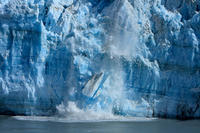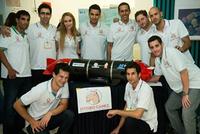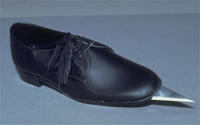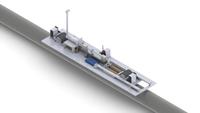-
New iceberg theory points to rapid disintegration, exacerbating sea level rise

In events that could exacerbate sea level rise over the coming decades, stretches of ice on the coasts of Antarctica and Greenland are at risk of rapidly cracking apart and falling into the ocean, according to new iceberg calving simulations from the University of Michigan.
-
-
Climate forecasts predict crop failures
Climate data can help predict some crop failures several months before harvest, according to a new study. Scientists found that in about one-third of global cropland, temperature and soil moisture have strong relationships to the yield of wheat and rice at harvest. For those two key crops, a computer model could predict crop failures three months in advance for about 20 percent of global cropland.
-
-
New underwater robots mimic designs found in nature
In recent years, robotic underwater vehicles have become more common in a variety of industrial and civil sectors. Now, a new class of underwater robot has emerged that mimics designs found in nature. These “biomimetic” vehicles promise to lead to new underwater technologies that could help the oil and gas industry, underwater humanitarian demining, environmental monitoring, search and rescue operations, anti-terrorist activities, harbor surveillance, coastal security and fisheries management, and more.
-
-
Young engineers compete in underwater robotics race
Student-built autonomous underwater vehicles will speed through the depths of a Navy pool in a battle for supremacy at the 16th International RoboSub Competition. The competition is being held this week (22-28 July). In addition to building autonomous underwater vehicles, teams are also responsible for creating Web sites and writing journal papers that outline their work.
-
-
Ben-Gurion University student team’s Hydro Camel competes in RoboSub Competition

Today, there are many remotely operated submarines that handle important tasks, such as checking underwater pipelines, mapping underwater minefields, searching for locations to place communication cables, and searching for sunken vessels. These marine vessels, however, are limited by effective communication cables and require frequent human-operator contact. Ben-Gurion University of the Negev is developing a more accurate and effective autonomous, independently thinking underwater vessel that would revolutionize these and other tasks. The BGU entry in the RoboSub Competition is called Hydro Camel.
-
-
U.K. water industry: fracking may contaminate U.K. drinking water
U.K. water companies have warned the shale gas industry that the quality of U.K. drinking water must be protected at all costs and fracking must not harm public health. Shale gas fracking could lead to contamination of the water supply with methane gas and harmful chemicals if not carefully planned and carried out.
-
-
Predicting what could happen if Hurricane hits

A Sandia National Laboratories team is gearing up for hurricane season, readying analyses to help people in the eye of a storm. The team has two jobs: conducting annual “hurricane swath” analyses of probable impacts on the Gulf Coast and East Coast, and providing quick analyses of crisis response in the face of an imminent hurricane threat to the United States. A swath analysis looks at how a hurricane might interrupt critical services and at impacts to infrastructure specific to an area, such as petroleum and petrochemical industries in Houston or financial services in New York City. It also looks at such things as the economic impact of the storm or how it could upset food deliveries.
-
-
Hollow-core optical fiber to enable high-power military sensors
The intensity of light that propagates through glass optical fiber is fundamentally limited by the glass itself. A novel fiber design using a hollow, air-filled core removes this limitation and significantly improves performance by forcing light to travel through channels of air, instead of the glass around it. DARPA’s spider-web-like, hollow-core fiber design is the first to demonstrate single-spatial-mode, low-loss and polarization control — key properties needed for advanced military applications such as high-precision fiber optic gyroscopes for inertial navigation.
-
-
Georgia Tech’s VentureLab ranks No. 2 among university-based incubators
Georgia Tech’s VentureLab helps create startup companies based on Georgia Tech research. Since its formation in 2001, VentureLab has launched more than 150 technology companies which have attracted more than $700 million in outside funding. VentureLab program has been ranked second in the world in a new benchmarking study. The study, conducted by UBI Index, examined 150 university-based business incubators in twenty-two different countries.
-
-
U.S. research universities subject to sustained cyberattack campaign by China
Leading U.S. research universities report that they have been subject to millions of Chinese hacking attempts weekly. The Chinese are aware that universities, and the professors who do research under the schools’ auspices, receive thousands of patents each year in areas such as prescription drugs, computer chips, fuel cells, aircraft, medical devices, food production, and more. The Chinese government-sponsored cyberattacks on American research universities are an expansion of efforts by China to steal information that has commercial, political, or national security value.
-
-
CIA copied, employed “Q”-developed 007 outlandish gadgets

The real-life CIA copied and employed a few outlandish gadgets from James Bond movies. The CIA was successful copying Rosa Klebb’s infamous spring-loaded poison knife shoe from the film From Russia with Love, but was less successful trying to copy the homing beacon device used in Goldfinger to track the villain’s car. The CIA version had “too many bugs in it,” former CIA director Allen Dulles would later say, and stopped working when the enemy entered a crowded city.
-
-
Dealing with man-made earthquakes
Between 1967 and 2000, central and eastern United States experienced on average 20 earthquakes above a magnitude 3.0 a year. Between 2010 and 2012, the number of earthquakes above a magnitude 3.0 in these regions has dramatically increased to an average of 100 a year. This increase in earthquakes prompts two important questions: Are they natural, or man-made? And what should be done in the future as we address the causes and consequences of these events to reduce associated risks?
-
-
STEM education and U.S. national security
Los Alamos National Laboratory director Charlie McMillan will be one of seventeen speakers at this year’s TEDxABQ. TEDxABQ is an independently organized event in Albuquerque, New Mexico, affiliated with the popular TED Talks series.McMillan will discuss the linkage between early education in science, technology, engineering, and mathematics (known as STEM) and national security.
-
-
Crawling robot examines, evaluates condition of load-bearing cables

Severe weather events inflict damage and destruction. The condition of infrastructure and its components may contribute to the overall damage: weak components and damaged elements make infrastructure less likely to withstand the stress of a storm. Researchers have developed a crawling robot capable of examining and evaluating the condition of load-bearing cables, such as those found in bridges, elevators, and cable cars.
-
-
Mother Nature offers best protection for coastal communities’ infrastructure
Extreme weather, sea-level rise, and degraded coastal ecosystems are placing people and property at greater risk of damage from coastal hazards. The likelihood and magnitude of losses can be reduced by intact ecosystems near vulnerable coastal communities. Scientists say that natural habitats such as dunes and reefs are critical to protecting millions of U.S. residents and billions of dollars in property from coastal storms.
-
More headlines
The long view
Autonomous Vehicle Technology Vulnerable to Road Object Spoofing and Vanishing Attacks
Researchers have demonstrated the potentially hazardous vulnerabilities associated with the technology called LiDAR, or Light Detection and Ranging, many autonomous vehicles use to navigate streets, roads and highways. The researchers have shown how to use lasers to fool LiDAR into “seeing” objects that are not present and missing those that are – deficiencies that can cause unwarranted and unsafe braking or collisions.
Tantalizing Method to Study Cyberdeterrence
Tantalus is unlike most war games because it is experimental instead of experiential — the immersive game differs by overlapping scientific rigor and quantitative assessment methods with the experimental sciences, and experimental war gaming provides insightful data for real-world cyberattacks.
Prototype Self-Service Screening System Unveiled
TSA and DHS S&T unveiled a prototype checkpoint technology, the self-service screening system, at Harry Reid International Airport (LAS) in Las Vegas, NV. The aim is to provide a near self-sufficient passenger screening process while enabling passengers to directly receive on-person alarm information and allow for the passenger self-resolution of those alarms.
Falling Space Debris: How High Is the Risk I'll Get Hit?
An International Space Station battery fell back to Earth and, luckily, splashed down harmlessly in the Atlantic. Should we have worried? Space debris reenters our atmosphere every week.
Testing Cutting-Edge Counter-Drone Technology
Drones have many positive applications, bad actors can use them for nefarious purposes. Two recent field demonstrations brought government, academia, and industry together to evaluate innovative counter-unmanned aircraft systems.
Strengthening the Grid’s ‘Backbone’ with Hydropower
Argonne-led studies investigate how hydropower could help add more clean energy to the grid, how it generates value as grids add more renewable energy, and how liner technology can improve hydropower efficiency.
